April 22, 2013
Nursing Path
Introduction
Risk factors include:
-
Preexisting medical problems assciated with agitation or dehydration.
-
Neurological conditions
-
Human immunodefi
ciency virus (HIV) infection
-
Rapid neuroleptization
-
High doses of antipsychotics
-
Coadministration of
lithium with an antipsychotic
-
Male gender than female
-
Younger age
-
A previous diagnosis
of a mood disorder
Clinical fetaures include:
-
Severe muscle rigidity
-
Hypepyrexia
-
Labile vital signs (tachycardia, unstable or elevated blood pressure)
-
Laboratory evidence of muscle injury (elevation of
creatine kinase)
-
Leukocytosis.
-
Diaphoresis
-
Dysphagia
-
Tremor
-
Incontinence
-
Mutism
Differential diagnosis
-
CNS infection
-
Status epilepticus
-
Subcortical brain lesions
-
Porphyria
-
Tetanus
-
Lethal catatonia
-
Heat stroke
-
Warm, humid climates
Treatment
-
Discontinue
the antipsychotic
-
Supportive care in medical ICU
-
Monitor vital signs
-
Cooling blankets for fever
-
Administer antipyretics
-
Cardiac monitoring for arrhythmias
-
Parenteral hydration
for dehydration
-
Monitoring for urine output and renal
function
-
Hemodialysis in acute renal failure associated with myoglobinuria
-
Bromocriptine- dopamine agonist (5 to 10 mg orally three times a day)
-
Dantrolene- muscle relaxant
-
Administer intravenous dantrolene 1–3 mg/kg
body weight/day, divided q.i.d.
-
Treatment of NMS should be individualized for each patient based on clinical signs and symptoms.
-
Electroconvulsive
therapy (ECT) is another treatment option in NMS
References
-
Miyamoto S, Merrill DB, Lieberman JA, Fleischacker WW, Marder SR. Antipsychotic Drugs. In Psychiatry,
Third Edition. Edrs. Allan Tasman, Jerald Kay, Jeffrey A. Lieberman,
Michael B. First and Mario Maj.John Wiley & Sons, Ltd, 2008.
- Daniel DG, Igan MF, Wolf SS. Neuropsychiatric Aspects of Movement Disorders. In Comprehensive
Textbook of Psychiatry , Vol 7 , Kaplan HI and Saddock BJ (eds). Williams & Wilkins , Baltimore, MD, USA .












0 comments:
Post a Comment